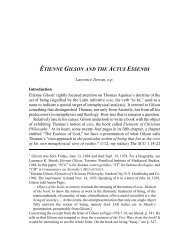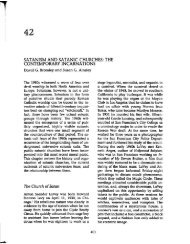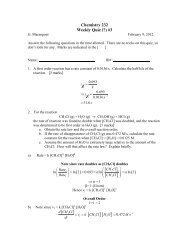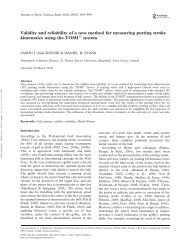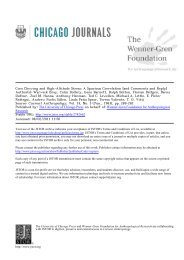CHAPTER13 RETURN, RISK, AND THE SECURITY MARKET LINE
CHAPTER13 RETURN, RISK, AND THE SECURITY MARKET LINE
CHAPTER13 RETURN, RISK, AND THE SECURITY MARKET LINE
Create successful ePaper yourself
Turn your PDF publications into a flip-book with our unique Google optimized e-Paper software.
<strong>CHAPTER13</strong><br />
<strong>RETURN</strong>, <strong>RISK</strong>, <strong>AND</strong> <strong>THE</strong> <strong>SECURITY</strong> <strong>MARKET</strong> <strong>LINE</strong><br />
1. (LO1) The portfolio weight of an asset is total investment in that asset divided by the total portfolio<br />
value. First, we will find the portfolio value, which is:<br />
Total value = 180($45) + 140($27) = $11,880<br />
The portfolio weight for each stock is:<br />
WeightA = 180($45)/$11,880 = .6818<br />
WeightB = 140($27)/$11,880 = .3182<br />
5. (LO1) The expected return of an asset is the sum of the probability of each return occurring times the<br />
probability of that return occurring. So, the expected return of the asset is:<br />
E(R) = .25(–.08) + .75(.21) = .1375 or 13.75%<br />
10. (LO1, 2)<br />
a. This portfolio does not have an equal weight in each asset. We first need to find the return of the<br />
portfolio in each state of the economy. To do this, we will multiply the return of each asset by<br />
its portfolio weight and then sum the products to get the portfolio return in each state of the<br />
economy. Doing so, we get:<br />
Boom: E(Rp) = .30(.3) + .40(.45) + .30(.33) = .3690 or 36.90%<br />
Good: E(Rp) = .30(.12) + .40(.10) + .30(.15) = .1210 or 12.10%<br />
Poor: E(Rp) = .30(.01) + .40(–.15) + .30(–.05) = –.0720 or –7.20%<br />
Bust: E(Rp) = .30(–.06) + .40(–.30) + .30(–.09) = –.1650 or –16.50%<br />
And the expected return of the portfolio is:<br />
E(Rp) = .15(.3690) + .45(.1210) + .35(–.0720) + .05(–.1650) = .0764 or 7.64%<br />
b. To calculate the standard deviation, we first need to calculate the variance. To find the variance,<br />
we find the squared deviations from the expected return. We then multiply each possible<br />
squared deviation by its probability, than add all of these up. The result is the variance. So, the<br />
variance and standard deviation of the portfolio is:<br />
σp 2 = .15(.3690 – .0764) 2 + .45(.1210 – .0764) 2 + .35(–.0720 – .0764) 2 + .05(–.1650 – .0764) 2<br />
σp 2 = .02436<br />
σp = (.02436) 1/2 = .1561 or 15.61%<br />
12. (LO4) The beta of a portfolio is the sum of the weight of each asset times the beta of each asset. If the<br />
portfolio is as risky as the market it must have the same beta as the market. Since the beta of the<br />
market is one, we know the beta of our portfolio is one. We also need to remember that the beta of the<br />
risk-free asset is zero. It has to be zero since the asset has no risk. Setting up the equation for the beta<br />
of our portfolio, we get:
βp = 1.0 = 1 /3(0) + 1 /3(1.38) + 1 /3(βX)<br />
Solving for the beta of Stock X, we get:<br />
βX = 1.62<br />
13. (LO1, 4) CAPM states the relationship between the risk of an asset and its expected return. CAPM is:<br />
E(Ri) = Rf + [E(RM) – Rf] × βi<br />
Substituting the values we are given, we find:<br />
E(Ri) = .052 + (.11 – .052)(1.05) = .1129 or 11.29%<br />
18. (LO1, 4) First, we need to find the β of the portfolio. The β of the risk-free asset is zero, and the<br />
weight of the risk-free asset is one minus the weight of the stock, the β of the portfolio is:<br />
ßp = wW(1.25) + (1 – wW)(0) = 1.25wW<br />
So, to find the β of the portfolio for any weight of the stock, we simply multiply the weight of the<br />
stock times its β.<br />
Even though we are solving for the β and expected return of a portfolio of one stock and the risk-free<br />
asset for different portfolio weights, we are really solving for the SML. Any combination of this<br />
stock, and the risk-free asset will fall on the SML. For that matter, a portfolio of any stock and the<br />
risk-free asset, or any portfolio of stocks, will fall on the SML. We know the slope of the SML line is<br />
the market risk premium, so using the CAPM and the information concerning this stock, the market<br />
risk premium is:<br />
E(RW) = .152 = .053 + MRP(1.25)<br />
MRP = .099/1.25 = .0792 or 7.92%<br />
So, now we know the CAPM equation for any stock is:<br />
E(Rp) = .053 + .0793βp<br />
The slope of the SML is equal to the market risk premium, which is 0.0792. Using these equations to fill in<br />
the table, we get the following results:<br />
wW E(Rp) ßp<br />
0.00% 5.30% 0.000<br />
25.00% 7.78% 0.313<br />
50.00% 10.25% 0.625<br />
75.00% 12.73% 0.938<br />
100.00% 15.20% 1.250<br />
125.00% 17.68% 1.563<br />
150.00% 20.15% 1.875
21. (LO1, 2) For a portfolio that is equally invested in large-company stocks and long-term bonds:<br />
Return = (10.23% + 8.57%)/2 = 9.40%<br />
For a portfolio that is equally invested in small stocks and Treasury bills:<br />
Return = (12.12% + 6.44%)/2 = 9.28%<br />
25. (LO2, 4) We are given the expected return of the assets in the portfolio. We also know the sum of the<br />
weights of each asset must be equal to one. Using this relationship, we can express the expected<br />
return of the portfolio as:<br />
E(Rp) = .185 = wX(.172) + wY(.136)<br />
.185 = wX(.172) + (1 – wX)(.136)<br />
.185 = .172wX + .136 – .136wX<br />
.049 = .036wX<br />
wX = 1.36111<br />
And the weight of Stock Y is:<br />
wY = 1 – 1.36111<br />
wY = –.36111<br />
The amount to invest in Stock Y is:<br />
Investment in Stock Y = –.36111($100,000)<br />
Investment in Stock Y = –$36,111.11<br />
A negative portfolio weight means that you short sell the stock. If you are not familiar with short<br />
selling, it means you borrow a stock today and sell it. You must then purchase the stock at a later date<br />
to repay the borrowed stock. If you short sell a stock, you make a profit if the stock decreases in<br />
value.<br />
To find the beta of the portfolio, we can multiply the portfolio weight of each asset times its beta and<br />
sum. So, the beta of the portfolio is:<br />
βP = 1.36111(1.40) + (–.36111)(0.95)<br />
βP = 1.56<br />
26. (LO3) The amount of systematic risk is measured by the β of an asset. Since we know the market risk<br />
premium and the risk-free rate, if we know the expected return of the asset we can use the CAPM to<br />
solve for the β of the asset. The expected return of Stock I is:<br />
E(RI) = .25(.11) + .50(.29) + .25(.13) = .2050 or 20.50%<br />
Using the CAPM to find the β of Stock I, we find:<br />
.2050 = .04 + .08βI<br />
βI = 2.06<br />
The total risk of the asset is measured by its standard deviation, so we need to calculate the standard<br />
deviation of Stock I. Beginning with the calculation of the stock’s variance, we find:<br />
σI 2 = .25(.11 – .2050) 2 + .50(.29 – .2050) 2 + .25(.13 – .2050) 2<br />
σI 2 = .00728
σI = (.00728) 1/2 = .0853 or 8.53%<br />
Using the same procedure for Stock II, we find the expected return to be:<br />
E(RII) = .25(–.40) .40) + .50(.10) + .25(.56) = .0900<br />
Using the CAPM to find the β of Stock II, we find:<br />
.0900 = .04 + .08βII<br />
βII = 0.63<br />
And the standard deviation of Stock II is:<br />
σII 2 = .25(–.40 – .0900) 2 + .50(.10<br />
σII 2 = .11530<br />
σII = (.11530) 1/2 = .3396 or 33.96%<br />
+ .50(.10 – .0900) 2 + .25(.56 – .0900) 2<br />
Although Stock II has more ore total risk than I, it has much less systematic risk, since its beta is much<br />
smaller than I’s. Thus, I has more systematic risk, and II has more unsystematic and more total risk.<br />
Since unsystematic risk can be diversified away, I is actually the “riskie “riskier” r” stock despite the lack of<br />
volatility in its returns. Stock I will have a higher risk premium and a greater expected return.<br />
28. (LO1, 4)<br />
a. The expected return of an asset is the sum of the probability of each return occurring times the<br />
probability of f that return occurring. So, the expected return of each stock is:<br />
E(RA) = .15(–.08) .08) + .70(.13) + .15(.48) = .1510 or 15.10%<br />
E(RB) = .15(–.05) .05) + .70(.14) + .15(.29) = .1340 or 13.40%<br />
b. We can use the expected returns we calculated to find the slope of the Security Market Line. We<br />
know that the beta of Stock A is .25 greater than the beta of Stock B. Therefore, as beta<br />
increases by .25, the expected return on a security increases by .017 (= .1510 – .1340). The<br />
slope of the security market line (SML) equals:
SlopeSML = Rise / Run<br />
SlopeSML = Increase in expected return / Increase in beta<br />
SlopeSML = (.1510 – .1340) / .25<br />
SlopeSML = .0680 or 6.80%<br />
Since the market’s beta is 1 and the risk-free rate has a beta of zero, the slope of the Security<br />
Market Line equals the expected market risk premium. So, the expected market risk premium<br />
must be 6.8 percent.<br />
We could also solve this problem using CAPM. The equations for the expected returns of the<br />
two stocks are:<br />
E(RA) = .151 = Rf + (βB + .25)(MRP)<br />
E(RB) = .134 = Rf + βB(MRP)<br />
We can rewrite the CAPM equation for Stock A as:<br />
.151 = Rf + βB(MRP) + .25(MRP)<br />
Subtracting the CAPM equation for Stock B from this equation yields:<br />
.017 = .25MRP<br />
MRP = .068 or 6.8%<br />
which is the same answer as our previous result.


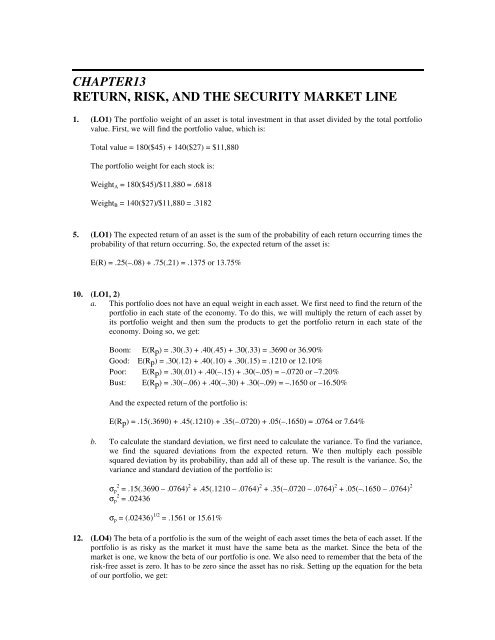
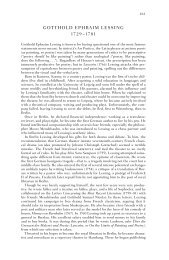

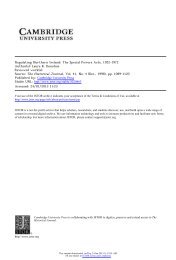

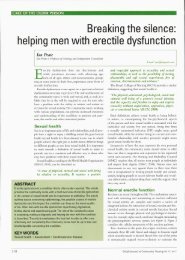
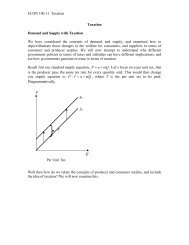
![The Rink - Cyril Dabydeen[1].pdf](https://img.yumpu.com/21946808/1/155x260/the-rink-cyril-dabydeen1pdf.jpg?quality=85)

